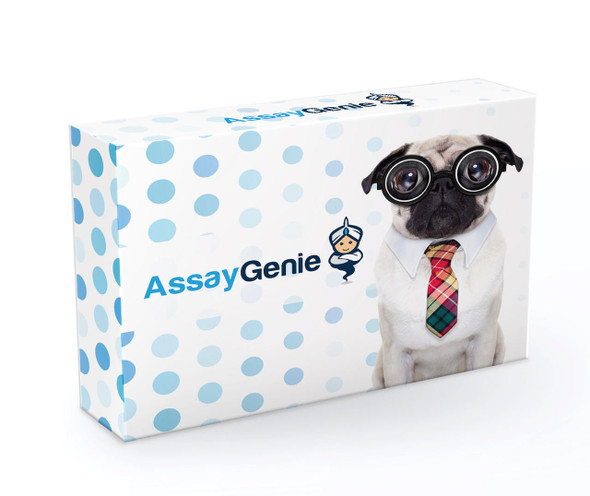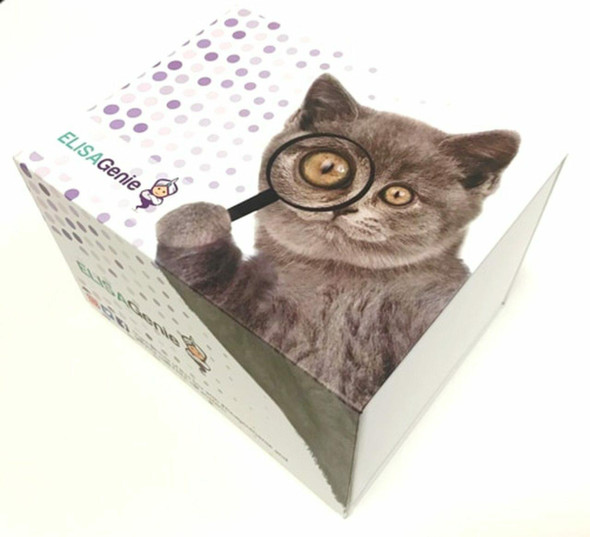Human ATGL(Adipose Triglyceride Lipase) ELISA Kit (HUES03567)
- SKU:
- HUES03567
- Product Type:
- ELISA Kit
- Size:
- 96 Assays
- Uniprot:
- Q96AD5
- Sensitivity:
- 0.38ng/mL
- Range:
- 0.63-40ng/mL
- ELISA Type:
- Sandwich
- Synonyms:
- Desnutrin, DKFZp667M109, FP17548, PEDF-R, TTS-2.2, TTS2, adipose triglyceride lipase, pigment epithelium-derived factor, transport-secretion protein 2.2, triglyceride hydrolase
- Reactivity:
- Human
- Sample Type:
- Serum, plasma and other biological fluids
- Research Area:
- Metabolism
Description
Human ATGL (Adipose Triglyceride Lipase) ELISA Kit
The Human ATGL (Adipose Triglyceride Lipase) ELISA Kit is a powerful tool for detecting ATGL levels in human adipose tissue samples. This kit offers unparalleled sensitivity and specificity, providing consistent and trustworthy results for various research purposes.ATGL is a key enzyme involved in the breakdown of triglycerides in adipose tissue, playing a crucial role in energy metabolism and lipid mobilization.
Dysregulation of ATGL has been linked to obesity, insulin resistance, and metabolic disorders, making it a valuable target for studying these conditions and developing therapeutic interventions.With its advanced technology and high-quality components, the Human ATGL ELISA Kit is an essential tool for researchers investigating the role of ATGL in adipose tissue metabolism and related health conditions.
| Assay type: | Sandwich |
| Format: | 96T |
| Assay time: | 4.5h |
| Reactivity: | Human |
| Detection Method: | Colormetric |
| Detection Range: | 0.63-40 ng/mL |
| Sensitivity: | 0.38 ng/mL |
| Sample Volume Required Per Well: | 100µL |
| Sample Type: | Serum, plasma and other biological fluids |
| Specificity: | This kit recognizes Human ATGL in samples. No significant cross-reactivity or interference between Human ATGL and analogues was observed. |
This ELISA kit uses Sandwich-ELISA as the method. The micro ELISA plate provided in this kit has been pre-coated with an antibody specific to Human ATGL. Standards or samples are added to the appropriate micro ELISA plate wells and combined with the specific antibody. Then a biotinylated detection antibody specific for Human ATGL and Avidin-Horseradish Peroxidase (HRP) conjugate are added to each micro plate well successively and incubated. Free components are washed away. The substrate solution is added to each well. Only those wells that contain Human ATGL, biotinylated detection antibody and Avidin-HRP conjugate will appear blue in color. The enzyme-substrate reaction is terminated by adding Stop Solution and the color turns yellow. The optical density (OD) is measured spectrophotometrically at a wavelength of 450 nm ± 2 nm. The OD value is proportional to the concentration of Human ATGL. The concentration of Human ATGL in samples can be calculated by comparing the OD of the samples to the standard curve.
| UniProt Protein Function: | Catalyzes the initial step in triglyceride hydrolysis in adipocyte and non-adipocyte lipid droplets (PubMed:15550674). Also has acylglycerol transacylase activity. May act coordinately with LIPE/HLS within the lipolytic cascade. Regulates adiposome size and may be involved in the degradation of adiposomes (PubMed:16239926). May play an important role in energy homeostasis. May play a role in the response of the organism to starvation, enhancing hydrolysis of triglycerides and providing free fatty acids to other tissues to be oxidized in situations of energy depletion. |
| NCBI Summary: | This gene encodes an enzyme which catalyzes the first step in the hydrolysis of triglycerides in adipose tissue. Mutations in this gene are associated with neutral lipid storage disease with myopathy. [provided by RefSeq, Jul 2010] |
| UniProt Code: | Q96AD5 |
| NCBI GenInfo Identifier: | 74731110 |
| NCBI Gene ID: | 57104 |
| NCBI Accession: | Q96AD5. 1 |
| UniProt Secondary Accession: | Q96AD5,O60643, Q5EFF5, Q6XYE5, Q96ET6, Q9NQ61, Q9NQ62 |
| UniProt Related Accession: | Q96AD5 |
| Molecular Weight: | 19,875 Da |
| NCBI Full Name: | Patatin-like phospholipase domain-containing protein 2 |
| NCBI Synonym Full Names: | patatin like phospholipase domain containing 2 |
| NCBI Official Symbol: | PNPLA2 |
| NCBI Official Synonym Symbols: | ATGL; TTS2; PEDF-R; FP17548; TTS-2. 2; iPLA2zeta; 1110001C14Rik |
| NCBI Protein Information: | patatin-like phospholipase domain-containing protein 2 |
| UniProt Protein Name: | Patatin-like phospholipase domain-containing protein 2 |
| UniProt Synonym Protein Names: | Adipose triglyceride lipase; Calcium-independent phospholipase A2; Desnutrin; IPLA2-zeta; Pigment epithelium-derived factor; TTS2. 2; Transport-secretion protein 2; TTS2 |
| UniProt Gene Name: | PNPLA2 |
As the OD values of the standard curve may vary according to the conditions of the actual assay performance (e. g. operator, pipetting technique, washing technique or temperature effects), the operator should establish a standard curve for each test. Typical standard curve and data is provided below for reference only.
| Concentration (ng/mL) | O.D | Average | Corrected |
| 40 | 2.454 2.478 | 2.466 | 2.393 |
| 20 | 1.617 1.649 | 1.633 | 1.56 |
| 10 | 0.971 0.967 | 0.969 | 0.896 |
| 5 | 0.457 0.481 | 0.469 | 0.396 |
| 2.5 | 0.262 0.238 | 0.25 | 0.177 |
| 1.25 | 0.176 0.174 | 0.175 | 0.102 |
| 0.63 | 0.121 0.131 | 0.126 | 0.053 |
| 0 | 0.072 0.074 | 0.073 | -- |
Precision
Intra-assay Precision (Precision within an assay): 3 samples with low, mid range and high level Human ATGL were tested 20 times on one plate, respectively.
Inter-assay Precision (Precision between assays): 3 samples with low, mid range and high level Human ATGL were tested on 3 different plates, 20 replicates in each plate.
| Intra-assay Precision | Inter-assay Precision | |||||
| Sample | 1 | 2 | 3 | 1 | 2 | 3 |
| n | 20 | 20 | 20 | 20 | 20 | 20 |
| Mean (ng/mL) | 2.02 | 3.71 | 17.09 | 1.98 | 3.80 | 16.99 |
| Standard deviation | 0.12 | 0.21 | 0.93 | 0.12 | 0.18 | 0.81 |
| C V (%) | 5.94 | 5.66 | 5.44 | 6.06 | 4.74 | 4.77 |
Recovery
The recovery of Human ATGL spiked at three different levels in samples throughout the range of the assay was evaluated in various matrices.
| Sample Type | Range (%) | Average Recovery (%) |
| Serum (n=5) | 87-102 | 95 |
| EDTA plasma (n=5) | 90-105 | 96 |
| Cell culture media (n=5) | 93-106 | 99 |
Linearity
Samples were spiked with high concentrations of Human ATGL and diluted with Reference Standard & Sample Diluent to produce samples with values within the range of the assay.
| Serum (n=5) | EDTA plasma (n=5) | Cell culture media (n=5) | ||
| 1:2 | Range (%) | 95-112 | 84-96 | 96-111 |
| Average (%) | 103 | 91 | 101 | |
| 1:4 | Range (%) | 93-105 | 86-97 | 81-94 |
| Average (%) | 98 | 92 | 87 | |
| 1:8 | Range (%) | 89-104 | 85-100 | 84-98 |
| Average (%) | 95 | 92 | 89 | |
| 1:16 | Range (%) | 93-106 | 88-100 | 82-95 |
| Average (%) | 99 | 93 | 89 |
An unopened kit can be stored at 4°C for 1 month. If the kit is not used within 1 month, store the items separately according to the following conditions once the kit is received.
| Item | Specifications | Storage |
| Micro ELISA Plate(Dismountable) | 8 wells ×12 strips | -20°C, 6 months |
| Reference Standard | 2 vials | |
| Concentrated Biotinylated Detection Ab (100×) | 1 vial, 120 µL | |
| Concentrated HRP Conjugate (100×) | 1 vial, 120 µL | -20°C(shading light), 6 months |
| Reference Standard & Sample Diluent | 1 vial, 20 mL | 4°C, 6 months |
| Biotinylated Detection Ab Diluent | 1 vial, 14 mL | |
| HRP Conjugate Diluent | 1 vial, 14 mL | |
| Concentrated Wash Buffer (25×) | 1 vial, 30 mL | |
| Substrate Reagent | 1 vial, 10 mL | 4°C(shading light) |
| Stop Solution | 1 vial, 10 mL | 4°C |
| Plate Sealer | 5 pieces | |
| Product Description | 1 copy | |
| Certificate of Analysis | 1 copy |
- Set standard, test sample and control (zero) wells on the pre-coated plate and record theirpositions. It is recommended to measure each standard and sample in duplicate. Note: addall solutions to the bottom of the plate wells while avoiding contact with the well walls. Ensuresolutions do not foam when adding to the wells.
- Aliquot 100µl of standard solutions into the standard wells.
- Add 100µl of Sample / Standard dilution buffer into the control (zero) well.
- Add 100µl of properly diluted sample (serum, plasma, tissue homogenates and otherbiological fluids) into test sample wells.
- Cover the plate with the sealer provided in the kit and incubate for 90 min at 37°C.
- Aspirate the liquid from each well, do not wash. Immediately add 100µL of BiotinylatedDetection Ab working solution to each well. Cover the plate with a plate seal and gently mix. Incubate for 1 hour at 37°C.
- Aspirate or decant the solution from the plate and add 350µL of wash buffer to each welland incubate for 1-2 minutes at room temperature. Aspirate the solution from each well andclap the plate on absorbent filter paper to dry. Repeat this process 3 times. Note: a microplatewasher can be used in this step and other wash steps.
- Add 100µL of HRP Conjugate working solution to each well. Cover with a plate seal andincubate for 30 min at 37°C.
- Aspirate or decant the solution from each well. Repeat the wash process for five times asconducted in step 7.
- Add 90µL of Substrate Reagent to each well. Cover with a new plate seal and incubate forapproximately 15 min at 37°C. Protect the plate from light. Note: the reaction time can beshortened or extended according to the actual color change, but not by more than 30min.
- Add 50 µL of Stop Solution to each well. Note: Adding the stop solution should be done inthe same order as the substrate solution.
- Determine the optical density (OD value) of each well immediately with a microplate readerset at 450 nm.









